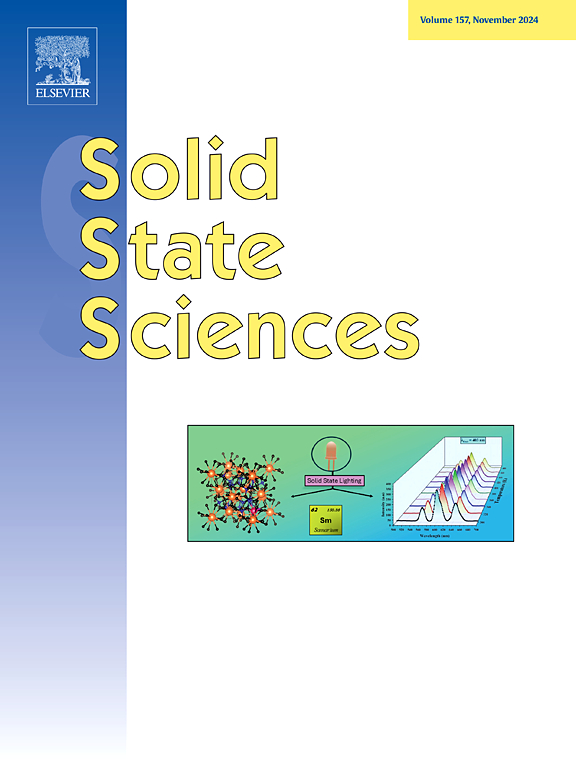Magnetic transition in MoO3: Influence of Mo5+/Mo6+ ratios on paramagnetic to diamagnetic behavior
IF 3.4
3区 化学
Q2 CHEMISTRY, INORGANIC & NUCLEAR
引用次数: 0
Abstract
This study examines the transition from paramagnetic to diamagnetic response in MoO3, a phenomenon previously documented in the literature where the magnetic response of MoO3 varies with the applied field, changing from paramagnetic at low fields to diamagnetic at high fields. MoO3 samples were synthesized with controlled Mo6+/Mo5+ ratios while maintaining high crystallinity to elucidate this phenomenon. The samples were prepared in a chemical vapor deposition (CVD) furnace under an oxygen environment at two different temperatures, 550 and 650 °C, and two annealing times, 4 and 8 h. The resulting samples were subjected to characterization using powder X-ray diffraction (XRD), Raman spectroscopy, Fourier transform infrared (FTIR) spectroscopy, X-ray photoelectron spectroscopy (XPS), and vibrating sample magnetometry (VSM). The XRD results demonstrated the formation of highly crystalline MoO3 in all samples, which is confirmed by Raman and FTIR. The XPS results demonstrate the concentration of Mo5+ and Mo6+ present in each sample. The results of the VSM experiments demonstrated that the observed change in the magnetic response of MoO3 is due to the intensity of the material's response being comparable to that of the sample holder's response. Moreover, vibrating sample magnetometry and X-ray photoelectron spectroscopy analysis revealed that MoO3 can exhibit both paramagnetic and diamagnetic behavior, depending on the quantity of Mo5+ present in the sample.

MoO3中的磁跃迁:Mo5+/Mo6+比值对顺磁性和反磁性行为的影响
本研究考察了MoO3的顺磁响应向抗磁响应的转变,这一现象在之前的文献中有记载,即MoO3的磁响应随外加磁场的变化而变化,从低磁场的顺磁到高磁场的抗磁。在保持高结晶度的情况下,通过控制Mo6+/Mo5+的比例合成MoO3样品来阐明这一现象。在化学气相沉积(CVD)炉中,在氧气环境下,在550℃和650℃两种不同温度下,在4和8 h两种退火时间下制备样品。利用粉末x射线衍射(XRD)、拉曼光谱(Raman spectroscopy)、傅里叶变换红外光谱(FTIR)、x射线光电子能谱(XPS)和振动样品磁强计(VSM)对样品进行了表征。XRD结果表明,所有样品都形成了高结晶的MoO3,拉曼光谱和红外光谱也证实了这一点。XPS结果表明,样品中存在Mo5+和Mo6+的浓度。VSM实验结果表明,观察到的MoO3的磁响应变化是由于材料的响应强度与样品支架的响应强度相当。此外,振动样品磁强计和x射线光电子能谱分析表明,MoO3可以表现出顺磁性和抗磁性,这取决于样品中Mo5+的含量。
本文章由计算机程序翻译,如有差异,请以英文原文为准。
求助全文
约1分钟内获得全文
求助全文
来源期刊

Solid State Sciences
化学-无机化学与核化学
CiteScore
6.60
自引率
2.90%
发文量
214
审稿时长
27 days
期刊介绍:
Solid State Sciences is the journal for researchers from the broad solid state chemistry and physics community. It publishes key articles on all aspects of solid state synthesis, structure-property relationships, theory and functionalities, in relation with experiments.
Key topics for stand-alone papers and special issues:
-Novel ways of synthesis, inorganic functional materials, including porous and glassy materials, hybrid organic-inorganic compounds and nanomaterials
-Physical properties, emphasizing but not limited to the electrical, magnetical and optical features
-Materials related to information technology and energy and environmental sciences.
The journal publishes feature articles from experts in the field upon invitation.
Solid State Sciences - your gateway to energy-related materials.
 求助内容:
求助内容: 应助结果提醒方式:
应助结果提醒方式:


